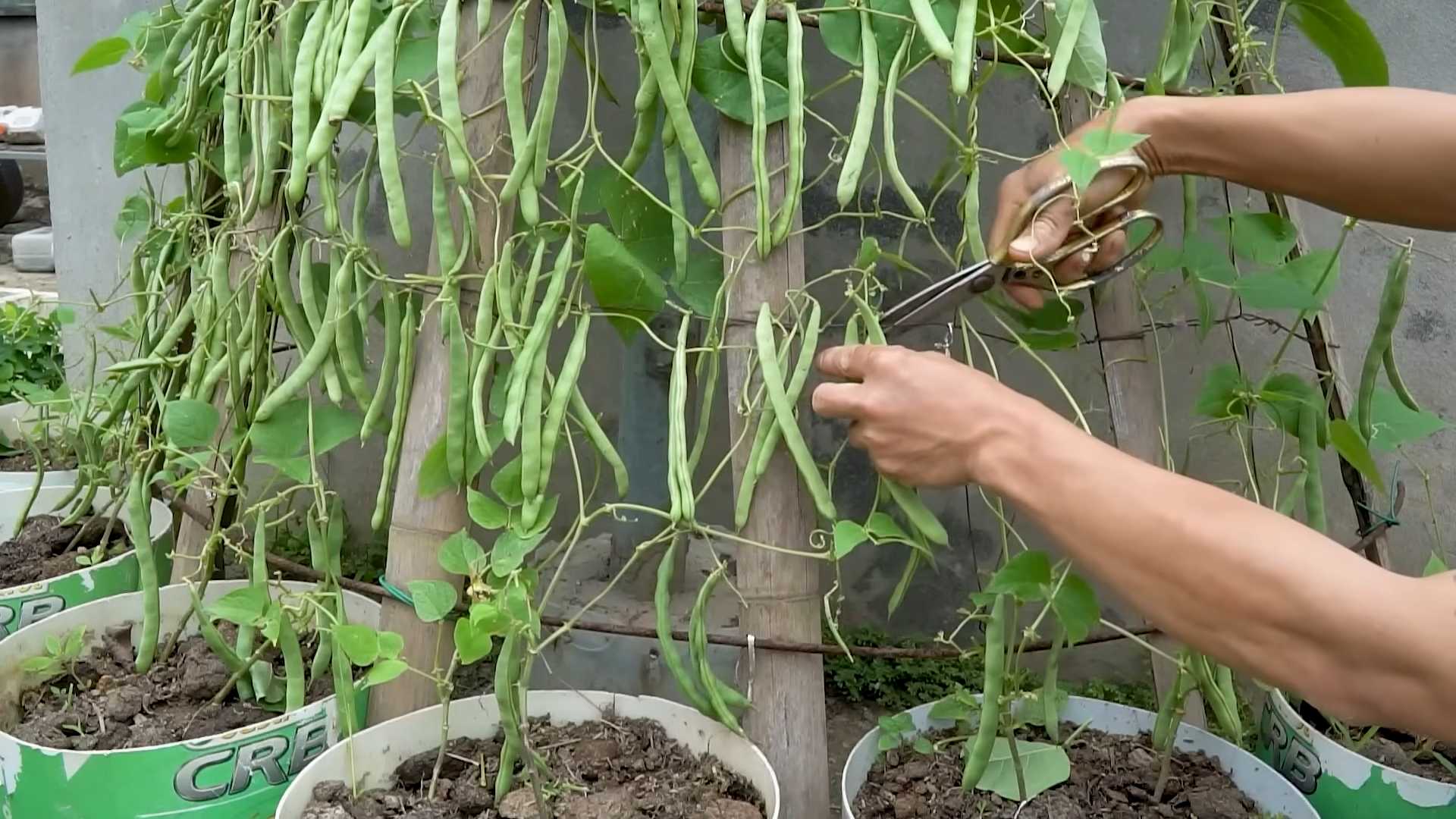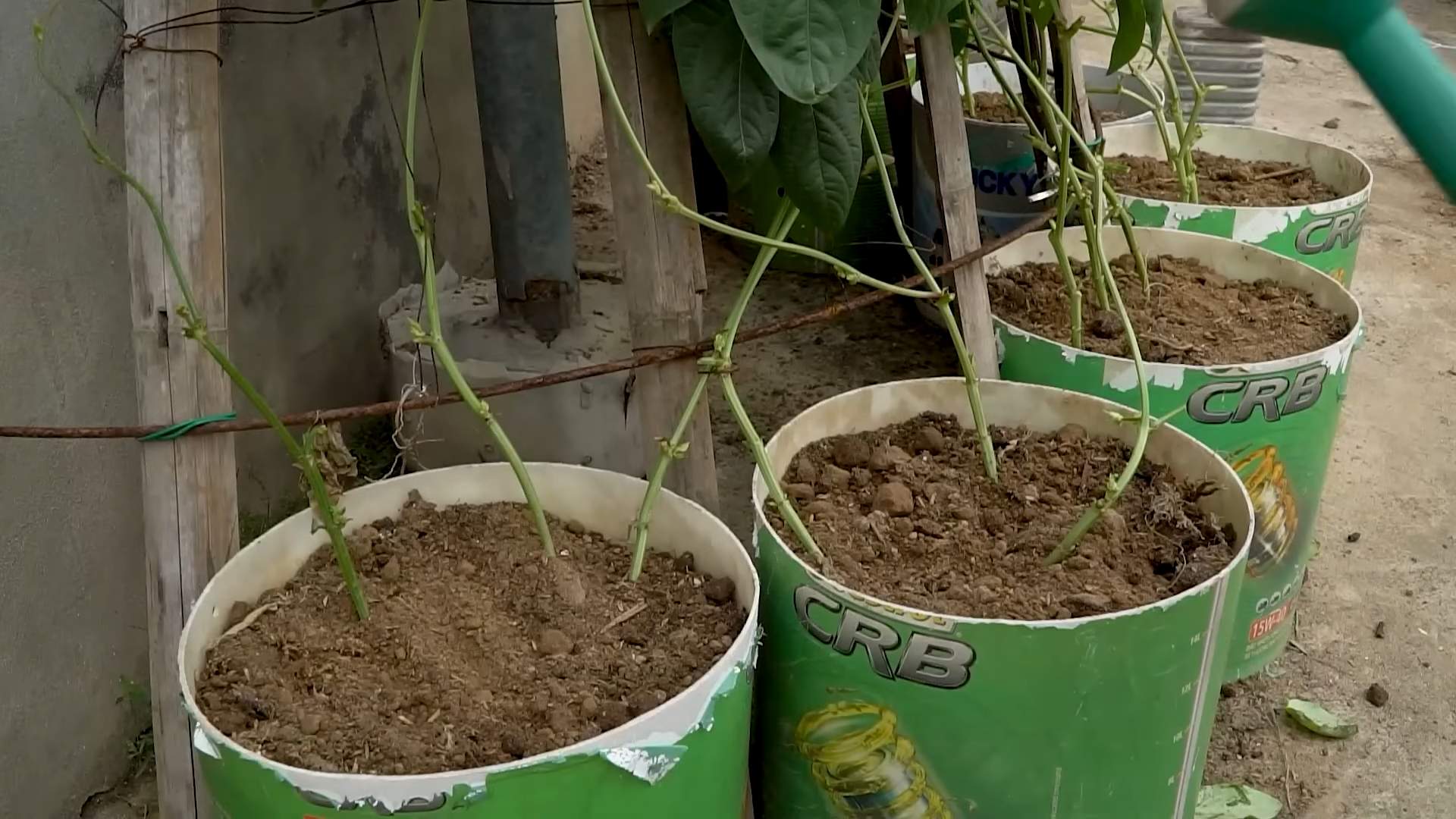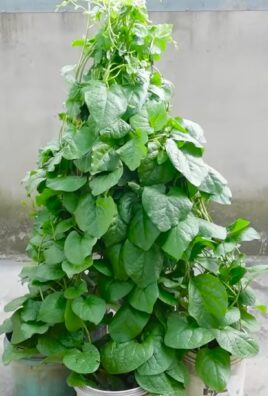Grow Long Beans Easily and watch your garden flourish with these impressive, delicious vegetables! Have you ever dreamt of harvesting armfuls of vibrant, dangling beans right from your own backyard? I know I have! There’s something incredibly satisfying about growing your own food, and long beans, with their impressive length and delightful flavor, are a fantastic choice for any home gardener.
Long beans, also known as yardlong beans or asparagus beans, have a rich history, particularly in Asian cuisine. They’ve been cultivated for centuries and are a staple ingredient in many traditional dishes. Beyond their culinary appeal, growing long beans offers a unique visual element to your garden, adding a touch of exotic charm.
But let’s be honest, sometimes getting those long beans to actually *grow* long and plentiful can feel like a challenge. That’s where these DIY tricks and hacks come in! I’m going to share some simple, yet effective techniques that will help you grow long beans easily, even if you’re a beginner gardener. We’ll cover everything from soil preparation and support structures to pest control and harvesting tips. Get ready to impress your friends and family with your bountiful harvest of these amazing beans!

Grow Long Beans Like a Pro: My Foolproof DIY Guide
Hey there, fellow gardening enthusiasts! I’m so excited to share my tried-and-true method for growing long beans (also known as yardlong beans or asparagus beans) that practically guarantees a bountiful harvest. Forget those spindly, disappointing yields – with this guide, you’ll be swimming in long beans before you know it! I’ve learned a lot over the years, and I’m confident this will help you.
Choosing the Right Variety and Location
Before we get our hands dirty, let’s talk about setting ourselves up for success. Choosing the right variety and location is crucial.
* Variety Selection: I’ve had great luck with ‘Red Noodle’ (for its vibrant color and delicious flavor), ‘Chinese Red Noodle’ (similar to the previous one), and ‘Orient Wonder’ (a classic green variety). Experiment to see what thrives in your area! Look for varieties that are disease-resistant and well-suited to your climate.
* Sunlight: Long beans are sun worshippers! They need at least 6-8 hours of direct sunlight each day. A south-facing location is ideal.
* Soil: Well-draining soil is a must. Long beans don’t like soggy feet. Amend your soil with compost or well-rotted manure to improve drainage and fertility. A slightly acidic to neutral pH (around 6.0-7.0) is perfect.
* Support System: These beans are climbers! You’ll need a sturdy trellis, fence, or teepee for them to grow on. I prefer a trellis made of strong wire mesh or wooden stakes. Make sure it’s at least 6-8 feet tall.
Preparing the Soil and Planting
Now for the fun part – getting those seeds in the ground!
1. Soil Preparation: A few weeks before planting, amend your soil with plenty of organic matter. I like to dig in a generous amount of compost and aged manure. This will provide essential nutrients and improve drainage. Remove any rocks, weeds, or debris from the planting area.
2. Starting Seeds (Optional): You can start long bean seeds indoors 2-3 weeks before the last expected frost. This gives them a head start, especially in cooler climates. Sow seeds in biodegradable pots filled with seed-starting mix. Keep the soil moist and warm (around 70-80°F). Once the seedlings have a few true leaves, you can transplant them outdoors after hardening them off.
3. Direct Sowing: This is my preferred method, as it’s less work. Wait until the soil has warmed up to at least 65°F (around 2-3 weeks after the last frost). Sow seeds directly into the ground, about 1 inch deep and 4-6 inches apart.
4. Watering: Water the seeds gently after planting. Keep the soil consistently moist but not waterlogged.
5. Mulching: Apply a layer of mulch around the plants to help retain moisture, suppress weeds, and regulate soil temperature. I use straw, shredded leaves, or wood chips.
Building a Sturdy Trellis
Long beans are vigorous climbers, so a strong trellis is essential. Here’s how I build mine:
1. Gather Materials: You’ll need sturdy wooden stakes (at least 8 feet long), wire mesh or strong twine, and a hammer or post driver.
2. Drive in the Stakes: Drive the stakes into the ground at regular intervals (about 4-6 feet apart) along the planting row. Make sure they are securely anchored.
3. Attach the Wire Mesh or Twine: Attach the wire mesh to the stakes using staples or wire. If using twine, create a grid pattern by tying the twine to the stakes horizontally and vertically. Ensure the trellis is taut and secure.
4. Reinforce (Optional): For extra support, you can add horizontal crossbars between the stakes. This will help prevent the trellis from sagging under the weight of the beans.
Caring for Your Long Bean Plants
Once your long beans are planted and the trellis is in place, it’s time to provide them with the care they need to thrive.
* Watering: Water regularly, especially during dry spells. Long beans need consistent moisture to produce long, healthy pods. Aim for about 1 inch of water per week. Water deeply at the base of the plants to avoid wetting the foliage, which can lead to fungal diseases.
* Fertilizing: Feed your long bean plants every 2-3 weeks with a balanced fertilizer. I like to use a liquid fertilizer diluted to half strength. Avoid over-fertilizing, as this can lead to excessive foliage growth at the expense of pod production.
* Weeding: Keep the planting area free of weeds. Weeds compete with long beans for nutrients and water. Hand-pull weeds regularly or use a hoe to cultivate the soil.
* Pest Control: Keep an eye out for common pests like aphids, bean beetles, and spider mites. I prefer to use organic pest control methods, such as insecticidal soap or neem oil. You can also attract beneficial insects to your garden to help control pests naturally.
* Training the Vines: As the long bean vines grow, gently guide them onto the trellis. They will naturally start to climb, but you may need to help them find their way. Tie the vines to the trellis with soft twine if necessary.
* Pruning: Pruning isn’t usually necessary for long beans, but you can remove any yellowing or damaged leaves to improve air circulation and prevent disease.
Harvesting Your Bountiful Crop
This is the moment we’ve all been waiting for! Harvesting your long beans is the most rewarding part of the process.
1. Timing: Long beans are typically ready to harvest about 60-80 days after planting. The pods should be long, slender, and firm. Harvest them when they are about 12-18 inches long, depending on the variety.
2. Harvesting Technique: Use scissors or pruning shears to cut the pods from the vine. Be careful not to damage the plant. Harvest regularly to encourage continued production.
3. Storage: Freshly harvested long beans are best eaten right away. You can store them in the refrigerator for a few days, but they will lose their crispness over time. To store them for longer, you can blanch and freeze them.
Troubleshooting Common Problems
Even with the best care, you may encounter some challenges when growing long beans. Here are some common problems and how to address them:
* Poor Germination: If your seeds aren’t germinating, make sure the soil is warm enough and consistently moist. You can also try soaking the seeds in water for 24 hours before planting to improve germination rates.
* Yellowing Leaves: Yellowing leaves can be a sign of nutrient deficiency, overwatering, or disease. Check the soil drainage and adjust your watering schedule accordingly. Fertilize with a balanced fertilizer to provide essential nutrients.
* Pest Infestations: Monitor your plants regularly for pests. Treat infestations promptly with organic pest control methods.
* Disease: Fungal diseases can be a problem in humid conditions. Improve air circulation by spacing plants properly and pruning any yellowing or damaged leaves. Avoid overhead watering.
* Lack of Pod Production: If your plants are growing well but not producing pods, it could be due to a lack of pollination. Long beans are self-pollinating, but bees and other pollinators can help. Attract pollinators to your garden by planting flowering plants nearby.
Extra Tips for Success
Here are a few extra tips that I’ve found helpful over the years:
* Succession Planting: Plant long beans every 2-3 weeks to ensure a continuous harvest throughout the growing season.
* Companion Planting: Plant long beans with companion plants like marigolds, basil, and rosemary to deter pests and attract beneficial insects.
* Saving Seeds: If you want to save seeds from your long beans, allow a few pods to mature completely on the vine. Once the pods are dry and brown, harvest the seeds and store them in a cool, dry place.
* Enjoy the Harvest: Long beans are delicious in stir-fries, salads, and soups. Experiment with different recipes and enjoy the fruits (or rather, beans) of your labor!
Growing long beans is a rewarding experience that anyone can enjoy. With a little planning and care, you can have a bountiful harvest of these delicious and nutritious vegetables. So get out there, get your hands dirty, and start growing! I hope this guide helps you achieve long bean success! Happy gardening!

Conclusion
So, there you have it! Growing long beans doesn’t have to be a daunting task reserved for seasoned gardeners. This simple, DIY trick unlocks a world of bountiful harvests, allowing even novice gardeners to enjoy the satisfaction of plucking fresh, vibrant long beans straight from their own backyard. The beauty of this method lies in its simplicity and adaptability. It’s a game-changer for anyone looking to maximize their yield and minimize the effort involved.
Why is this a must-try? Because it addresses the core challenges of long bean cultivation: providing adequate support for their vigorous growth and optimizing their access to sunlight and air circulation. By implementing this DIY technique, you’re essentially creating the ideal environment for your long beans to thrive. You’ll witness healthier plants, increased flower production, and ultimately, a significantly larger harvest of those delicious, elongated beans.
But don’t stop there! Feel free to experiment with variations to suit your specific needs and preferences. Consider using different materials for your support structure. Bamboo poles, sturdy branches, or even repurposed metal rods can all work effectively. You can also adjust the spacing between plants based on your garden’s layout and the specific variety of long beans you’re growing. Some gardeners have even successfully integrated this technique into vertical gardening systems, creating stunning and productive green walls.
Think about companion planting too! Marigolds can deter pests, while basil can improve the flavor of your long beans. Experiment with different combinations to find what works best for your garden.
The key takeaway is that this DIY trick empowers you to take control of your long bean cultivation. It’s a cost-effective, environmentally friendly, and incredibly rewarding way to grow your own food.
We wholeheartedly encourage you to give this DIY trick a try. You’ll be amazed at the difference it makes. And more importantly, we want to hear about your experiences! Share your photos, tips, and stories in the comments below. Let’s build a community of long bean enthusiasts and learn from each other’s successes (and even the occasional challenges!). Your insights could inspire others to embark on their own long bean growing journey.
Don’t just take our word for it – experience the joy of harvesting your own homegrown long beans. This simple DIY trick is your gateway to a more abundant and fulfilling gardening experience. So, grab your tools, gather your materials, and get ready to grow long beans like never before! Remember, successful gardening is a journey of experimentation and learning. Embrace the process, have fun, and enjoy the delicious rewards of your labor. This method will help you grow long beans easily and efficiently.
Frequently Asked Questions (FAQ)
What type of support structure is best for long beans?
The best type of support structure depends on your available resources and aesthetic preferences. Bamboo poles are a popular and readily available option, offering a natural and sturdy support. Trellises, whether homemade or store-bought, provide excellent vertical support and can be particularly useful in smaller gardens. You can also use sturdy branches, metal rods, or even repurposed materials like old ladders or fencing. The key is to ensure that the structure is tall enough (at least 6-8 feet) and strong enough to support the weight of the mature plants and their heavy crop of beans. Consider the overall look you want to achieve in your garden and choose a material that complements your existing landscape.
How far apart should I plant my long bean seeds or seedlings?
Spacing is crucial for healthy growth and optimal yield. Generally, long bean seeds or seedlings should be planted 4-6 inches apart within the row. Rows should be spaced 2-3 feet apart to allow for adequate airflow and access for harvesting. If you’re using a trellis system, you can plant the beans closer together, as they will be growing vertically. Overcrowding can lead to reduced yields and increased susceptibility to diseases. Observe your plants as they grow and adjust the spacing if necessary.
How often should I water my long beans?
Long beans require consistent moisture, especially during hot and dry periods. Water deeply and regularly, aiming to keep the soil consistently moist but not waterlogged. A good rule of thumb is to water 2-3 times per week, depending on the weather conditions. Mulching around the base of the plants can help retain moisture and suppress weeds. Avoid overhead watering, as this can increase the risk of fungal diseases. Instead, water at the base of the plants, using a soaker hose or drip irrigation system if possible.
What kind of fertilizer should I use for long beans?
Long beans benefit from a balanced fertilizer that provides essential nutrients for growth and pod production. A fertilizer with an NPK ratio of 10-10-10 or 14-14-14 is a good starting point. You can also use organic fertilizers like compost, aged manure, or bone meal. Apply fertilizer according to the package instructions, typically every 4-6 weeks. Avoid over-fertilizing, as this can lead to excessive foliage growth at the expense of pod production. Soil testing can help you determine the specific nutrient needs of your soil and guide your fertilizer choices.
How do I deal with pests and diseases on my long bean plants?
Long beans can be susceptible to various pests and diseases, including aphids, bean beetles, and fungal infections. Regular inspection of your plants is crucial for early detection and intervention. Handpicking pests, using insecticidal soap, or applying neem oil can help control infestations. Ensure good air circulation around your plants to prevent fungal diseases. Remove any infected leaves or plants promptly to prevent the spread of disease. Crop rotation and companion planting can also help reduce pest and disease pressure. Consider using organic pest control methods whenever possible to minimize the impact on beneficial insects and the environment.
When is the best time to harvest long beans?
Long beans are typically ready for harvest 60-90 days after planting. Harvest the beans when they are young, tender, and about 12-18 inches long. Regular harvesting encourages continued pod production. Use scissors or pruning shears to cut the beans from the vine, being careful not to damage the plant. Overripe beans will become tough and stringy. Harvest in the morning when the beans are at their peak freshness.
Can I grow long beans in containers?
Yes, long beans can be successfully grown in containers, provided you choose a large enough container (at least 12 inches in diameter and depth) and provide adequate support. Use a well-draining potting mix and ensure that the container receives at least 6-8 hours of sunlight per day. Water regularly and fertilize as needed. Container-grown long beans may require more frequent watering and fertilization than those grown in the ground. Choose a compact or bush variety of long beans for container gardening, as they tend to be more manageable.
My long bean plants are flowering, but not producing beans. What could be the problem?
There are several reasons why your long bean plants might be flowering but not producing beans. Insufficient pollination is a common cause. Ensure that there are pollinators, such as bees and butterflies, in your garden. You can attract pollinators by planting flowering herbs and vegetables nearby. High temperatures can also interfere with pollination. Water stress or nutrient deficiencies can also prevent pod formation. Ensure that your plants are receiving adequate water and fertilizer. In some cases, the variety of long beans you are growing may require specific pollination conditions.
Can I save seeds from my long beans for next year?
Yes, you can save seeds from your long beans for next year, but it’s important to choose open-pollinated varieties rather than hybrid varieties. Allow some of the beans to mature fully on the vine until they are dry and brown. Remove the seeds from the pods and allow them to dry completely. Store the seeds in an airtight container in a cool, dark, and dry place. Label the container with the variety and date. Seed saving is a great way to preserve genetic diversity and reduce your gardening costs.
What are some good companion plants for long beans?
Companion planting can enhance the growth and health of your long bean plants. Good companion plants for long beans include marigolds (which deter pests), basil (which improves flavor and repels insects), rosemary (which repels bean beetles), and carrots (which improve soil structure). Avoid planting long beans near onions or garlic, as they can inhibit growth. Companion planting is a natural and sustainable way to improve your garden’s ecosystem.





Leave a Comment